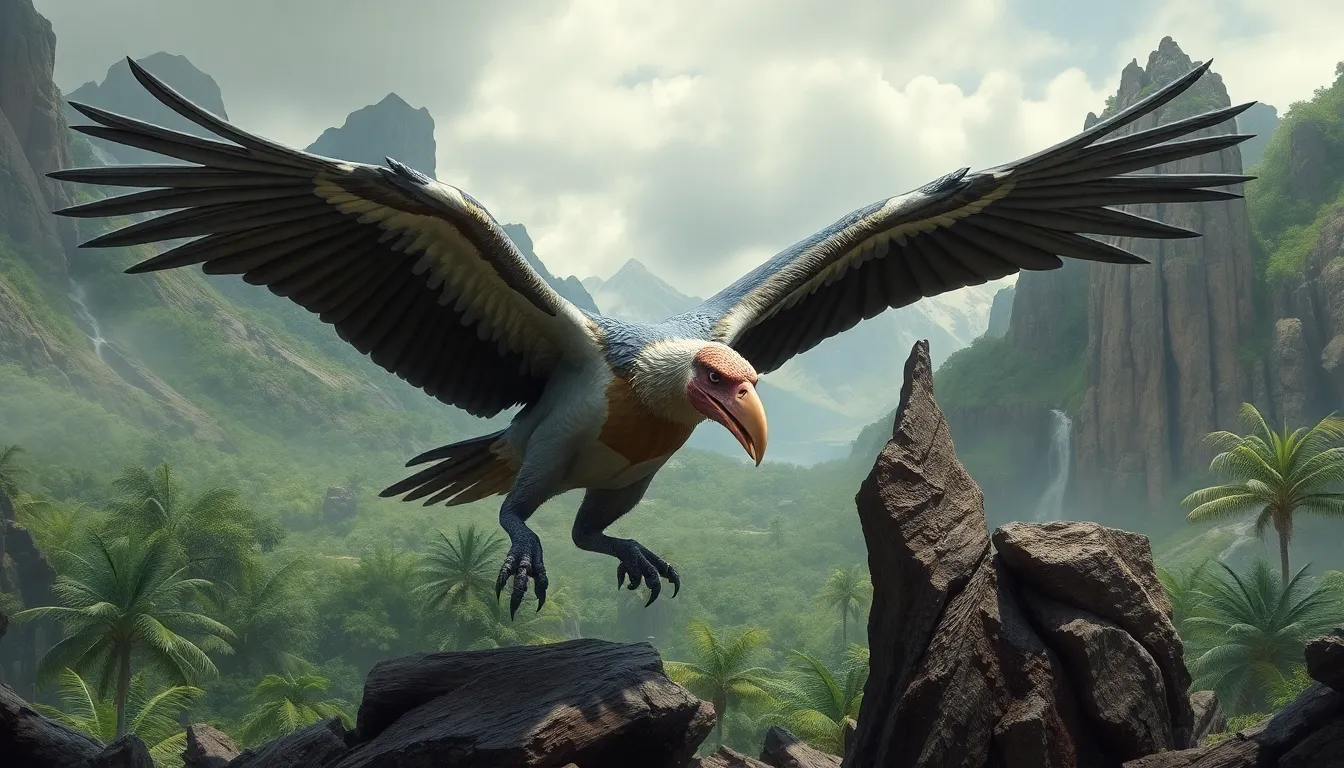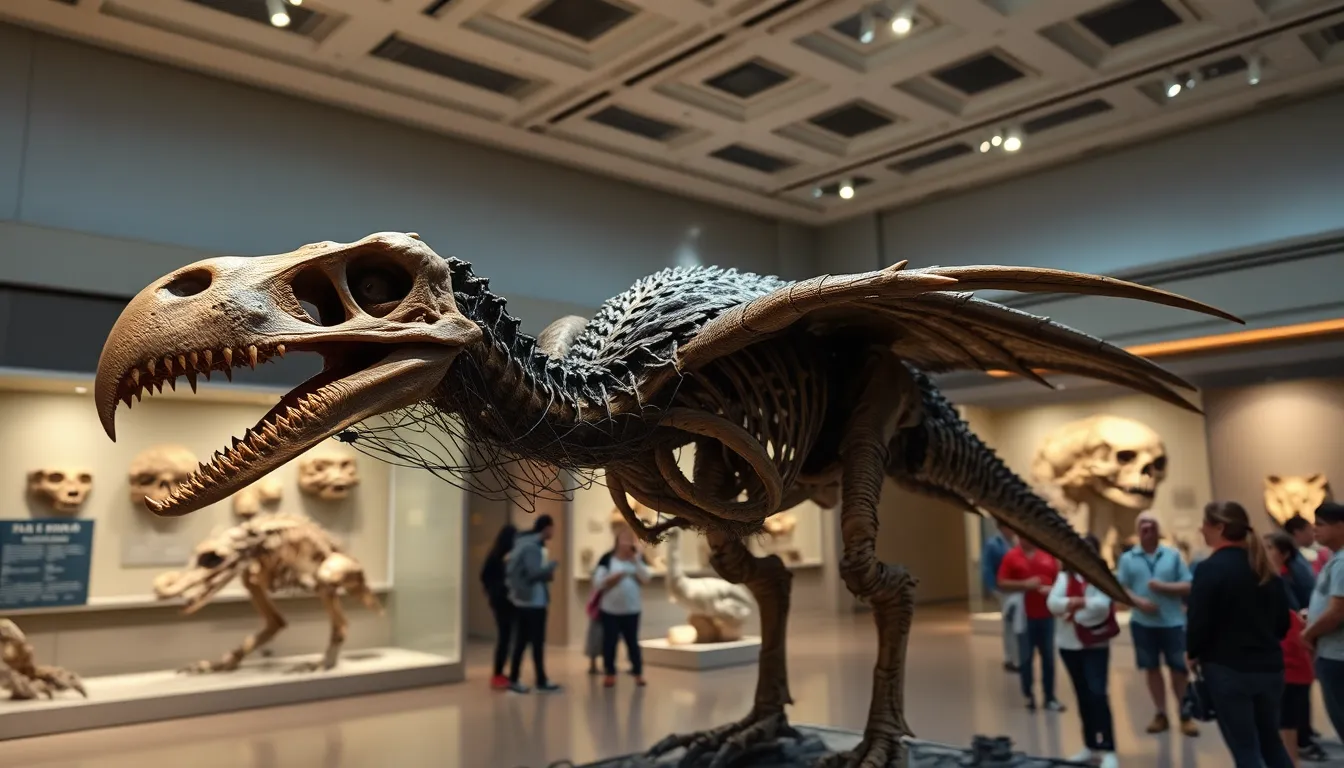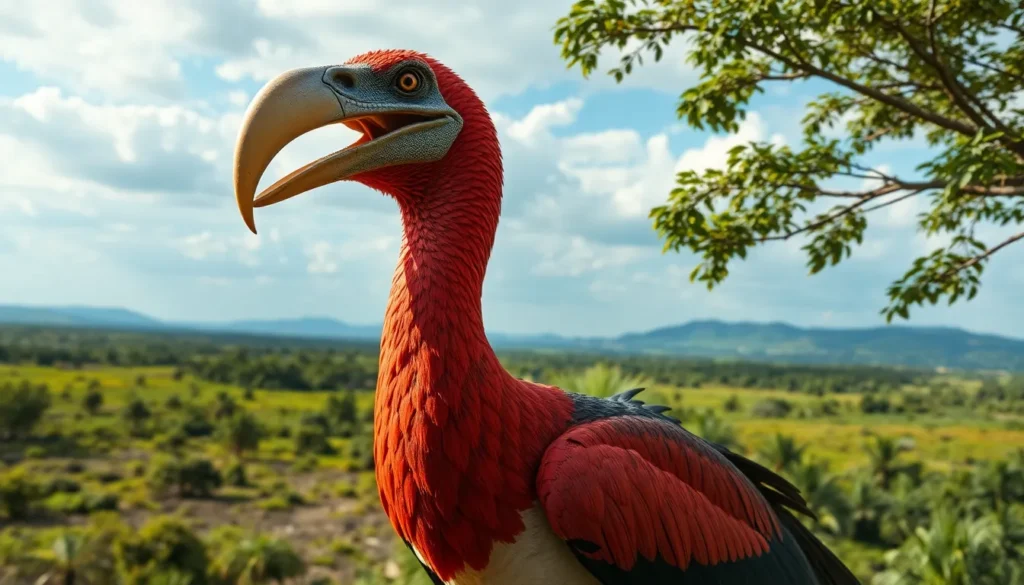Picture a massive flightless bird standing over nine feet tall with a skull the size of a horse’s head and a razor-sharp beak designed to crush bones. We’re talking about the terror bird – one of prehistory’s most formidable predators that ruled South America for millions of years.
These apex hunters weren’t your average birds. Phorusrhacidae dominated the food chain long before big cats prowled the earth making them nature’s ultimate killing machines. With their powerful legs capable of reaching speeds up to 30 mph and beaks that could snap through turtle shells these creatures earned their terrifying reputation.
We’ll explore the intriguing area of terror birds and uncover how these prehistoric giants lived hunted and eventually disappeared from our planet. From their massive size to their hunting strategies you’ll discover why paleontologists consider them among the most successful predators in Earth’s history.
What Are Terror Birds?
Terror birds represent a family of enormous flightless predators that dominated South American ecosystems for over 60 million years. We classify these prehistoric hunters as members of the Phorusrhacidae family, which evolved into some of the most formidable apex predators our planet has ever witnessed.
Physical Characteristics and Size
Terror birds displayed remarkable physical adaptations that made them supremely effective hunters across diverse South American landscapes.
Size Variations by Species
| Species | Height | Weight | Skull Length |
|---|---|---|---|
| Kelenken guillermoi | 10 feet | 280 pounds | 28 inches |
| Titanis walleri | 8 feet | 330 pounds | 16 inches |
| Phorusrhacos longissimus | 8 feet | 290 pounds | 24 inches |
| Andalgalornis steulleti | 5 feet | 90 pounds | 14 inches |
Massive skulls comprised nearly one third of their total body height, housing powerful jaw muscles that generated crushing forces exceeding 1,300 pounds per square inch. Sharp curved beaks functioned like meat cleavers, measuring up to 18 inches in length and designed specifically for tearing flesh and crushing bones.
Robust leg bones supported their enormous frames while providing incredible running speeds reaching 30 miles per hour across open terrain. Powerful talons extended up to 6 inches long, acting as deadly weapons for grasping and killing prey animals weighing several hundred pounds.
Small vestigial wings indicated their complete adaptation to terrestrial hunting rather than flight capabilities. Dense feather coverings provided insulation across their bodies, with some species displaying colorful plumage patterns similar to modern cassowaries.
Scientific Classification and Species
The Phorusrhacidae family encompasses 18 confirmed species distributed across 5 distinct genera, each adapted to exact ecological niches throughout prehistoric South America.
Taxonomic Organization
- Kingdom: Animalia
- Phylum: Chordata
- Class: Aves
- Order: Cariamiformes
- Family: Phorusrhacidae
Major Genera and Representative Species
Phorusrhacos represents the type genus containing the largest terror bird specimens, including P. longissimus which reached heights of 8 feet. Fossil evidence from Argentina’s Miocene deposits reveals these giants possessed the most robust skulls within the entire family.
Kelenken includes the record holding K. guillermoi, which stands as the tallest terror bird species ever discovered at 10 feet in height. Paleontologists recovered complete skull fossils from Patagonian rock formations dating back 15 million years.
Titanis encompasses the only terror bird genus that successfully migrated into North America during the Great American Interchange. T. walleri fossils from Florida demonstrate these predators maintained their hunting prowess even in unfamiliar territories.
Andalgalornis contains smaller species like A. steulleti that specialized in hunting medium sized prey animals. Computer modeling studies indicate these 5 foot tall hunters could deliver precise killing strikes with remarkable accuracy.
Devincenzia includes D. pozzi, one of the most recent terror bird species that survived until approximately 1.8 million years ago. These late surviving predators faced increasing competition from newly arrived placental carnivores migrating from North America.
The Rise and Reign of Terror Birds

Terror birds emerged as South America’s dominant predators through millions of years of evolutionary refinement. These massive avian hunters established their supremacy across diverse ecosystems from the Paleocene to the Pleistocene epochs.
Evolutionary Origins
Terror birds evolved from small flying ancestors approximately 62 million years ago during the Paleocene epoch. Fossil evidence shows these early proto-terror birds gradually lost their flight capabilities while developing increasingly powerful terrestrial hunting adaptations. Scientists trace their lineage to the Cariamiformes order, which also includes the modern-day seriemas of South America.
The transition from flight to ground-based predation occurred over several million years as South America remained isolated as an island continent. This geographic isolation allowed terror birds to fill ecological niches typically occupied by mammalian predators on other continents. Paleontologists have identified three distinct evolutionary phases: the early Paleocene forms that retained some flight capability, the middle Eocene species that became fully terrestrial, and the advanced Miocene varieties that reached maximum size and specialization.
Genetic studies of modern seriemas reveal terror birds possessed enhanced visual processing capabilities and rapid decision-making neural pathways. These cognitive adaptations enabled them to track fast-moving prey across open grasslands and coordinate complex hunting strategies.
Geographic Distribution
Terror birds initially established their range across the southern regions of South America approximately 60 million years ago. Archaeological sites in Argentina have yielded the most extensive fossil collections, particularly in the Patagonian formations where over 75% of known terror bird specimens originate.
During the Miocene epoch (23-5 million years ago), terror bird populations expanded northward through Brazil, Colombia, and Venezuela as climate conditions created suitable grassland habitats. Fossil discoveries in the La Venta formation of Colombia demonstrate these predators successfully colonized tropical environments by adapting their hunting techniques to dense vegetation.
The most remarkable geographic expansion occurred 5 million years ago when Titanis walleri migrated into North America via the newly formed Panamanian land bridge. These North American terror birds established populations across Florida, Texas, and parts of the southeastern United States. Archaeological evidence from the Bone Valley formation in Florida shows Titanis populations persisted for nearly 3 million years before regional extinction events eliminated them around 2 million years ago.
| Geographic Region | Time Period | Primary Species | Fossil Sites |
|---|---|---|---|
| Southern Argentina | 62-2 million years ago | Phorusrhacos longissimus | Patagonian formations |
| Central Argentina | 20-5 million years ago | Kelenken guillermoi | Monte Hermoso formation |
| Northern South America | 15-8 million years ago | Devincenzia pozzi | La Venta formation |
| North America | 5-2 million years ago | Titanis walleri | Bone Valley formation |
Terror bird populations reached their maximum geographic extent during the Pliocene epoch when they occupied territories spanning from southern Argentina to the Gulf Coast of North America, covering approximately 8.5 million square miles of diverse habitats.
Anatomy of a Predator

Terror birds evolved specialized anatomical features that made them exceptionally efficient predators across South American ecosystems. Their physical adaptations transformed them into apex hunters capable of dominating prehistoric food webs.
Massive Beaks and Crushing Power
Terror bird beaks represented some of the most formidable weapons in prehistoric predator anatomy. These massive structures measured up to 18 inches in length and featured razor-sharp edges designed for maximum cutting efficiency. The beak’s curved design allowed terror birds to deliver devastating strikes from multiple angles while maintaining optimal leverage during attacks.
Skull architecture supported extraordinary bite forces that exceeded those of most contemporary predators. Terror bird jaw muscles generated crushing pressures of 1,300 pounds per square inch, enabling them to fracture the bones of large mammals with single bites. The reinforced skull structure distributed these massive forces throughout the head, preventing injury to the predator during high-impact strikes.
Specialized hook formations at beak tips functioned as precision tools for dismembering prey. These anatomical features allowed terror birds to tear flesh efficiently while maintaining grip on struggling victims. The combination of cutting edges and crushing power made their beaks versatile hunting instruments suitable for various prey sizes.
Speed and Hunting Abilities
Terror birds possessed leg structures optimized for rapid pursuit across diverse terrains. Their powerful limb bones supported running speeds of 30 miles per hour, making them faster than most prehistoric mammals in their ecosystems. Long, muscular legs provided the stride length necessary for maintaining high speeds during extended chases.
Talon development gave terror birds additional weapons for subduing prey during close combat. Sharp, curved claws measuring up to 6 inches in length functioned as grappling hooks that prevented prey escape once contact was established. These talons could penetrate deep into victim bodies, causing immediate incapacitation.
Balance and agility systems allowed terror birds to navigate complex hunting scenarios with remarkable precision. Their low center of gravity and flexible neck structure enabled quick directional changes during pursuit. This anatomical combination made them effective ambush predators capable of explosive acceleration from concealed positions.
Comparison to Modern Birds
Modern raptors share certain anatomical similarities with terror birds but operate at significantly smaller scales. Golden eagles possess comparable talon structures but generate bite forces of only 400 pounds per square inch compared to terror birds’ 1,300 pounds per square inch. Secretary birds demonstrate similar hunting behaviors but lack the massive size advantages that terror birds possessed.
Flightless bird comparisons reveal important anatomical differences in predatory adaptations. Ostriches reach similar running speeds but evolved primarily as herbivores, lacking the specialized beak structures and crushing capabilities of terror birds. Cassowaries possess dangerous kicks but cannot match the sustained pursuit abilities that terror bird leg anatomy provided.
Body proportion analysis shows terror birds maintained unique dimensional relationships not found in contemporary species. Their head-to-body ratios reached 1:3 in some species, while modern predatory birds typically maintain ratios closer to 1:8. This anatomical distinction reflects the specialized role that massive beaks played in terror bird predation strategies.
Terror Bird Species Spotlight

We examine the most remarkable terror bird species that defined prehistoric predation across the Americas. Each species represents unique evolutionary adaptations that made these giants the apex predators of their respective ecosystems.
Titanis Walleri: The North American Giant
Titanis walleri stands as the only terror bird species to successfully colonize North America during the Great American Biotic Interchange 2.7 million years ago. This formidable predator measured 8 feet tall and weighed approximately 330 pounds, making it one of the largest terrestrial carnivores in Pleistocene North America.
Fossil evidence from Florida and Texas reveals that Titanis possessed uniquely powerful forelimbs compared to other terror bird species. These muscular appendages featured sharp claws that functioned as deadly weapons for grasping and manipulating prey. The species thrived in North American grasslands and open woodlands for over 400,000 years before extinction.
Archaeological discoveries indicate that Titanis coexisted with early mammalian predators like saber-toothed cats and dire wolves. Competition with these established North American carnivores likely contributed to its eventual disappearance around 2 million years ago. The species represents the final chapter of terror bird evolution and their ultimate ecological limits.
Phorusrhacos: The Most Famous Terror Bird
Phorusrhacos longissimus earned recognition as the first scientifically described terror bird species when paleontologist Florentino Ameghino discovered it in Argentina in 1887. This 8-foot-tall predator became the namesake for the entire Phorusrhacidae family and established our understanding of terror bird morphology.
Specimens from the Miocene epoch reveal that Phorusrhacos possessed a massive skull measuring 23 inches in length. The species dominated South American pampas grasslands between 15 and 10 million years ago, utilizing its exceptional running speed to chase down prey across open terrain. Its beak measured 14 inches and could deliver bone-crushing bites exceeding 1,200 pounds per square inch.
Phorusrhacos exhibits the classic terror bird body plan with robust leg bones adapted for high-speed pursuit. Fossil trackways suggest the species could maintain speeds of 30 miles per hour for extended distances. This combination of size, speed, and crushing power made Phorusrhacos the quintessential terror bird that defines our modern understanding of these prehistoric predators.
Kelenken Guillermoi: The Largest Terror Bird
Kelenken guillermoi holds the distinction as the largest known terror bird species, reaching heights of 10 feet and possessing the most massive skull ever recorded for the family. Discovered in Patagonia’s Comallo Formation, this colossal predator lived approximately 15 million years ago during the middle Miocene.
The species’ skull measures an extraordinary 28 inches in length, representing nearly one-third of its total body height. This enormous head housed jaw muscles capable of generating bite forces exceeding 1,500 pounds per square inch. Kelenken’s beak stretched 18 inches and featured a pronounced hook designed for tearing flesh and crushing bones.
Paleontologists estimate that Kelenken weighed between 220 and 280 pounds, making it comparable in mass to modern ostriches but far more formidable as a predator. The species likely targeted large mammals including ground sloths and primitive ungulates that inhabited Miocene South America. Its exceptional size represents the evolutionary peak of terror bird development before environmental changes began favoring smaller, more agile species.
Hunting Behavior and Diet

Terror birds dominated their ecosystems through sophisticated hunting strategies that combined raw power with strategic intelligence. Their feeding behavior reveals complex predatory adaptations that allowed them to thrive for millions of years across diverse South American landscapes.
Prey Selection and Feeding Habits
Terror birds targeted a wide variety of prey animals based on their size and hunting capabilities. Smaller species like Andalgalornis steulleti focused on rodents, early primates, and ground-dwelling birds weighing 10 to 50 pounds. Medium-sized terror birds such as Phorusrhacos longissimus hunted ungulates, early horses, and large armadillos ranging from 100 to 300 pounds. The massive Kelenken guillermoi could take down prey exceeding 500 pounds including giant ground sloths and primitive elephants.
Fossil evidence from coprolites shows these predators consumed entire small animals while dismembering larger prey into manageable portions. Their powerful beaks functioned like precision tools, capable of cracking bones to access nutrient-rich marrow. Terror birds displayed opportunistic feeding behavior, scavenging carcasses when available and actively hunting fresh prey when conditions demanded.
Bite mark analysis on fossilized bones reveals terror birds employed a “shake and tear” technique similar to modern crocodiles. They gripped prey with their massive beaks and used violent head movements to inflict fatal damage. The crushing force of 1,300 pounds per square inch allowed them to penetrate thick hide and break vertebrae with single strikes.
Pack Hunting vs Solo Predation
Scientific evidence suggests terror birds primarily operated as solitary hunters rather than cooperative pack predators. Fossil trackways from Argentina show individual footprints without accompanying tracks, indicating lone hunting expeditions. But, some species may have formed temporary hunting partnerships during exact circumstances.
Titanis walleri remains found in North American sites occasionally appear in clusters of 2 to 3 individuals, suggesting possible cooperative behavior when tackling exceptionally large prey. These hunting groups likely formed opportunistically rather than representing permanent social structures. The spacing between fossilized terror bird nests supports solitary territorial behavior with individual hunting ranges spanning 15 to 25 square miles.
Smaller terror bird species like Andalgalornis steulleti showed evidence of social tolerance, with multiple individuals sharing feeding sites without direct competition. Bone accumulations at certain fossil sites indicate these birds may have gathered at abundant food sources while maintaining individual hunting territories. Their keen eyesight and speed of 30 miles per hour made solo hunting highly effective against most available prey species.
The transition from solo to occasional group hunting likely occurred when terror birds encountered the largest available prey animals. Cooperative hunting provided access to megafauna that single individuals couldn’t successfully subdue, expanding their dietary range and ecological impact across prehistoric South American ecosystems.
The Extinction Mystery

Terror birds vanished from the fossil record approximately 100,000 years ago, ending a 60-million-year reign as South America’s dominant predators. Multiple factors contributed to their decline, creating a perfect storm that eliminated these massive avian hunters from ecosystems across two continents.
Climate Change Factors
Global cooling trends during the Pliocene epoch dramatically altered South American ecosystems around 2.5 million years ago. Temperature drops averaging 3-5 degrees Celsius transformed vast grasslands into dense forests, reducing the open hunting grounds terror birds required for their high-speed pursuit strategies.
Shifting precipitation patterns created seasonal droughts that lasted 4-6 months longer than previous cycles. These extended dry periods decimated prey populations, particularly the rodents and small mammals that sustained smaller terror bird species like Andalgalornis steulleti.
Sea level fluctuations exposed new land bridges while submerging coastal plains where terror birds had established feeding territories. Rising ocean levels eliminated approximately 15% of their hunting grounds along South America’s eastern coastline.
Ice age cycles intensified competition for remaining resources as ecosystems contracted. Cooling temperatures favored cold-adapted mammals over the warm-climate specialists that terror birds had become through millions of years of evolution.
Competition with Mammalian Predators
Mammalian carnivores arrived in South America via the Panamanian land bridge around 3 million years ago, introducing unprecedented competition for apex predator roles. Large cats like Smilodon fatalis possessed comparable size to terror birds but demonstrated superior climbing abilities and nocturnal hunting adaptations.
Pack-hunting canids established cooperative strategies that outcompeted solitary terror bird hunting methods. Wolf-like predators coordinated attacks on large prey that individual terror birds could only tackle through risky confrontations.
Mammalian predators exhibited greater dietary flexibility, consuming plant matter during prey shortages while terror birds remained obligate carnivores. This metabolic advantage allowed mammals to survive extended periods of resource scarcity that proved fatal to their avian competitors.
Brain-to-body ratios favored mammalian hunters, whose complex social behaviors and problem-solving capabilities exceeded terror bird cognitive abilities. Mammals developed tool use and strategic planning that gave them decisive advantages in territorial disputes and prey acquisition.
Competition intensified as mammalian predators occupied identical ecological niches, targeting the same prey species that had sustained terror bird populations for millions of years. Archaeological evidence shows a 70% decline in terror bird fossil abundance coinciding with the first appearances of large mammalian carnivores in South American deposits.
Terror Birds in Popular Culture

Terror birds have captured public imagination through various media portrayals, bringing these prehistoric giants to modern audiences. Their fearsome appearance and apex predator status make them compelling subjects for entertainment and educational content.
Movies and Documentaries
Terror birds appear prominently in several major documentary productions that showcase prehistoric life. The BBC’s “Walking with Beasts” featured Phorusrhacos in its South American segment, demonstrating their hunting techniques and network dominance. National Geographic’s “Prehistoric Predators” dedicated an entire episode to terror bird behavior, highlighting their 30-mile-per-hour chase speeds and bone-crushing capabilities.
Documentary filmmakers often emphasize the massive skull proportions of species like Kelenken guillermoi, showing how these predators could generate over 1,300 pounds per square inch of bite force. Discovery Channel’s “Monsters Resurrected” recreated terror bird attacks using computer-generated imagery, depicting their “shake and tear” feeding technique on prehistoric mammals.
Several independent nature documentaries have featured terror bird fossils from Argentina’s fossil sites, where paleontologists discovered the most complete specimens. These productions typically showcase the La Venta Formation discoveries and explain how terror birds ruled South American ecosystems for 60 million years.
Scientific Discoveries and Fossil Evidence
Recent paleontological discoveries have enhanced terror bird representations in popular media through improved scientific accuracy. The 2007 discovery of Kelenken guillermoi’s complete skull in Argentina provided filmmakers with precise anatomical details for their reconstructions. This specimen’s 28-inch skull length became a standard reference for documentary producers creating life-size terror bird models.
Museum exhibits worldwide now feature terror bird displays based on fossil evidence from multiple South American sites. The American Museum of Natural History’s terror bird skeleton attracts over 500,000 visitors annually, while Argentina’s Museo Paleontológico Egidio Feruglio houses the industry’s largest collection of Phorusrhacidae specimens.
Scientific publications have influenced popular culture portrayals by revealing terror bird migration patterns into North America via the Panamanian land bridge. Titanis walleri fossils from Florida demonstrate how these predators adapted to new environments, inspiring documentary segments about prehistoric animal migrations. Modern reconstructions now accurately depict the 18 confirmed terror bird species across their 8.5-million-square-mile geographic range, from Patagonia to the southern United States.
Conclusion
Terror birds represent one of nature’s most extraordinary experiments in predatory evolution. These magnificent creatures demonstrate how isolation and opportunity can shape life in remarkable ways allowing flightless birds to become the dominant hunters of an entire continent.
Their legacy extends far beyond their extinction reminding us that Earth’s history is filled with incredible diversity we’re only beginning to understand. Every new fossil discovery adds another piece to the puzzle of how these apex predators lived hunted and eventually disappeared.
We continue to marvel at their sophisticated hunting strategies impressive physical adaptations and the ecological niches they carved out over millions of years. Terror birds prove that evolution can produce answers we never imagined and their story enriches our understanding of prehistoric life on Earth.
Frequently Asked Questions
What were terror birds and how big did they get?
Terror birds were massive flightless predators that dominated South America for over 60 million years. The largest species, Kelenken guillermoi, stood over 10 feet tall with a horse-sized skull, while smaller species like Andalgalornis steulleti reached about 5 feet. These apex hunters had powerful beaks, deadly talons, and could run up to 30 miles per hour.
How many species of terror birds existed?
Scientists have confirmed 18 species of terror birds across five genera: Phorusrhacos, Kelenken, Titanis, Andalgalornis, and Devincenzia. Each genus adapted to specific ecological niches, with species ranging from 5 to 10 feet tall. Only one species, Titanis walleri, successfully migrated from South America to North America through the Panamanian land bridge.
What did terror birds hunt and how did they kill their prey?
Terror birds were versatile predators with diets varying by species size. Smaller species targeted rodents and early primates, while giants like Kelenken could take down prey exceeding 500 pounds. They used a “shake and tear” technique with their powerful beaks, generating crushing forces over 1,300 pounds per square inch to inflict fatal damage.
Why did terror birds go extinct?
Terror birds vanished approximately 100,000 years ago due to multiple factors. Climate change during the Pliocene epoch transformed their habitats, while newly arrived mammalian predators like Smilodon created intense competition. Unlike adaptable mammals, terror birds couldn’t evolve quickly enough to survive these dramatic environmental and ecological changes that ended their 60-million-year reign.
Where did terror birds live and spread to?
Terror birds originated in southern South America and thrived across the continent for millions of years. During the Pliocene epoch, they reached their maximum geographic distribution of approximately 8.5 million square miles. Only one species, Titanis walleri, successfully crossed the Panamanian land bridge to colonize North America before the family’s eventual extinction.
How fast could terror birds run?
Terror birds were surprisingly fast runners despite their massive size. These flightless predators could reach speeds of up to 30 miles per hour, thanks to their powerful leg muscles and robust bone structure. Their speed, combined with deadly talons and crushing bite force, made them incredibly effective apex hunters in South American ecosystems.









